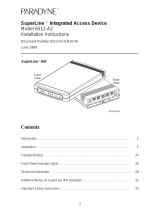
E6
Declaration of Conformity
Products that display the crossed-out wheeled bin logo cannot
be disposed of as domestic waste. These products must be
disposed of at facilities capable of re-cycling them
and appropriately handling any waste by-products.
Contact your local authority for details of the
nearest such facility. Appropriate recycling and
waste disposal helps conserve resources and
protects the environment from contamination.
7 Declaration of Conformity
Naim Audio declares that Naim Audio products are in conformance with:
Low Voltage Directive 2006/95/EC
Electromagnetic Compatibility Directive 2004/108/EC
Restriction of Hazardous Substances (RoHS2) Directive 2011/65/EU
Waste of Electrical and Electronic Equipment Directive 2002/96/EC
Energy Related Products (ErP), Directive 2009/125/EC
Naim Audio products comply with the following standards:
EN60065 - Audio, video and similar electronic apparatus - Safety requirements
EN55013 - Sound and television broadcast receivers and associated equipment - Radio disturbance
characteristics
EN55020 - Sound and television broadcast receivers and associated equipment - Immunity
characteristics
EN61000-3-2 - Mains harmonics current emissions
EN61000-3-3 - Mains flicker emissions
8 Statutory Safety Warnings
In order to comply with current European safety regulations it
is essential that the Naim loudspeaker connectors supplied with
amplifiers and loudspeakers are used.
Do not under any circumstances allow anyone to modify your
Naim equipment without first checking with the factory, your
retailer, or your distributor. Unauthorised modifications will
invalidate your guarantee.
Equipment must not be exposed to dripping or splashing and no
objects filled with liquid, such as vases, should be placed on the
equipment.
For your own safety do not under any circumstances open Naim
equipment without first disconnecting it from the mains.
Warning: an apparatus with CLASS I construction shall be
connected to a mains socket outlet with a protective earthing
connection.
Warning: batteries installed shall not be exposed to excessive
heat such as sunshine, fire or the like.
Where the mains plug or an appliance coupler is used as the
disconnect device, the disconnect device shall remain readily
operable. To disconnect the equipment from the mains remove
the mains plug from the mains outlet.
The following label is attached to all mains powered equipment:
WARNING
THIS APPARATUS
MUST BE EARTHED
This equipment has been tested and found to comply with the
relevant EMC and Safety Standards, and, where applicable, also
complies with the limits for a class B digital device, pursuant to
Part 15 of the FCC Rules.
These limits are designed to provide reasonable protection
against harmful interference in a residential installation. This
equipment generates, uses and can radiate radio frequency and,
if not installed and used in accordance with the instructions,
may cause harmful interference to radio communications.
However, there is no guarantee that interference will not occur
in a particular installation. If this equipment does cause harmful
interference to radio or television reception, which can be
determined by turning off and on, the user is encouraged to
try to correct the interference by one or more of the following
measures:
• Reorient or relocate the receiving antenna.
• Increase the separation between the equipment and the
receiver.
• Connect the equipment into an outlet on a circuit different
from that to which the receiver is connected.
• Consult your Naim retailer or an experienced radio/TV
technician for help.
Note
To the fullest extent permitted by applicable law, Naim Audio
Ltd. disclaims all liability for any loss or damages whether real,
incidental or consequential that arise from using this product.
Naim Audio Limited, its agents and representatives, cannot
be held responsible for the loss of any data or content from a
Naim/NaimNet server, however caused.
Naim Audio Ltd, Southampton Road, Salisbury, England SP1 2LN
Tel: +44 (0) 1722 426600 Fax: +44 (0)871 230 1012
W: www.naimaudio.com
Part No. 12-001-0258 Iss. 1B















